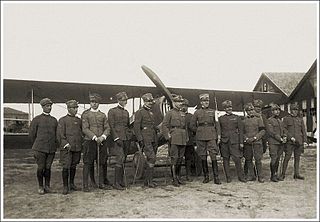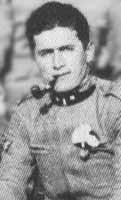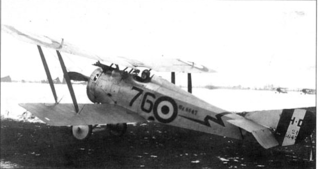Capitano Giulio Lega was a World War I flying ace credited with five aerial victories. After finishing the war, he completed medical school, and began a near lifelong career caring for the Italian Chamber of Deputies.
CapitanoGuido Masiero was a World War I flying ace credited with five confirmed and ten unconfirmed aerial victories. He was a prewar lancer who used his civilian engineering expertise to wrangle a transfer to aviation duty.
Tenente ColonnelloGiorgio Michetti was a World War I flying ace credited with five aerial victories.
Tenente-colonnello Alessandro Resch was an Italian World War I flying ace credited with five confirmed aerial victories. After surviving World War I, he would become a pioneering airline captain, flying 500,000 miles between 1928 and 1935. He would return to the Italian Air Force as a major in 1935, rising to tenente-colonnello by 1939. His participation in World War II is unknown.
Tenente Giovanni Sabelli was an Italian World War I flying ace credited with five aerial victories. At the start of World War I, he was already an experienced combat pilot.

Sergente Cesare Magistrini began his lengthy aviation career as a World War I flying ace credited with six confirmed and four unconfirmed aerial victories.
MarescialloGuido Nardini (1881-1928) was a World War I flying ace credited with six aerial victories.

Tenente Luigi Olivi (1894–1917) was an Italian World War I flying ace credited with six aerial victories. He won two awards of the Silver Medal for Military Valor and was killed in action.
Sergente Romolo Ticconi was a World War I flying ace credited with six aerial victories.

TenenteLeopoldo Eleuteri was a World War I flying ace credited with seven aerial victories.

TenenteMario Fucini was a World War I flying ace who claimed credit for 13 aerial victories during the war; seven of these were confirmed in 1919.

Tenente di VascelloOrazio Pierozzi (1884–1919) was a World War I flying ace credited with seven aerial victories.

Antonio Riva was an Italian pilot and a World War I flying ace, credited with seven confirmed and seven unconfirmed aerial victories. In 1951, he was executed by firing squad under the newly established People's Republic of China for allegedly conspiring to assassinate Mao Zedong and other Communist leaders.
TenenteLuigi Olivari was a World War I flying ace who claimed 19 aerial victories. His Spad VII stalled into a fatal crash on 13 October 1917. Posthumously, he was awarded credit for eight aerial victories.
Tenente Gastone Novelli was a World War I flying ace credited with eight aerial victories.

Tenente colonnelloAlvaro Leonardi was a World War I Sottotenente from Italy and a flying ace credited with eight aerial victories.
Flaminio Avet was a World War I flying ace credited with eight aerial victories. Although born in Nice, France, he served in the Italian military as Italy entered World War I. After a transfer from Lancers to aviation, he trained as a pilot. He began his aerial combat career on 27 November 1918, and would stake a dozen victory claims, eight of which would be verified. He ended the war having won the Silver Medal for Military Valor three times. He returned to Nice postwar, and died there on 21 August 1928.

LieutenantGiovanni 'Giannino' Ancillotto was an Italian World War I flying ace credited with 11 confirmed aerial victories. Rather unusually, he served solely with aviation while he was in the military, beginning in the lowest rank. Among his aerial victories as a fighter pilot were three over enemy observation balloons right after the Battle of Caporetto. As an example of the hazards of balloon busting, on 5 December 1917 Ancillotto returned to base with singed swatches of the third balloon's fabric adhering to his damaged fighter plane.

76a Squadriglia of the Corpo Aeronautico Militare was one of Italy's original fighter squadrons, being founded during World War I on 25 May 1916. On 30 May 1916, the new unit began its combat career. Between 22 April and 3 October 1917, three of its commanding officers became casualties. It was drawn into the air fighting over Caporetto in late 1917, and forced to retreat three times during November as a consequence of the Italian defeat.

81a Squadriglia was an Italian fighter squadron raised in March 1917 that served through the end of World War I. One of its aces, Flavio Baracchini, would become the first awardee of the Gold Medal for Military Valor. The squadron would be credited with 34 aerial victories, and suffer four dead. It ended the war with 28 aircraft on strength.










